 |
| |
| |

(EPILOGUE)
DETECTIVE COMICS
#518
(SEPTEMBER 1982)
|
| |
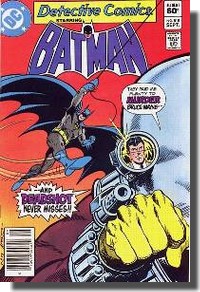 |
|
"DO YOU THINK
HE'LL BE OKAY
?"
"CERTAINLY MY SON --THE SERUM AND
THE TRANSFUSION
WILL HAVE HIM RESTORED TO NORMAL IN
HOURS."
"SEE ? -- THE FANGS
HAVE RECEDED ALREADY !"
"The
Millionaire Contract"
Story - Gerry Conway
& Paul Levitz
Art - Don Newton
Inks - Bruce Patterson
Colours - Adrienne Roy
Lettering - Ben Oda
Editor - Dick Giordano
Cover - Jim Aparo
|
|
|
| |
PLOT SUMMARY
To all
intents and purposes, the story arc featuring Batman and
Robin turned into vampires by the Monk effectively came
to an end in Batman #351 with the defeat of
both the Monk and his sister Dala and Father Green
administering the serum which would restore the Dynamic
Duo back to their normal selves.
|
| |
| However,
Gerry Conway carried the final
touches over into Detective
Comics #518 and started that
issue with something akin to an
epilogue to the vampires story
arc. In the
Batcave, an already recovered
Robin (who Batman insisted be
treated first because being
Dala's first victim he was most
affected by the vampiric virus in
his blood), a content Father
Green, and a still perplexed
Alfred gaze upon Batman who is in
the final stages of the blood
transfusion which, thanks to the
serum the clergyman was able to
produce from the Monk's blood
sample procured by the Darknight
Detective, will also return the
Batman to his true self.
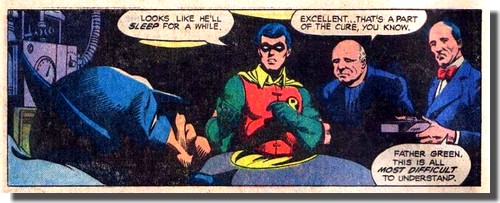
|
|
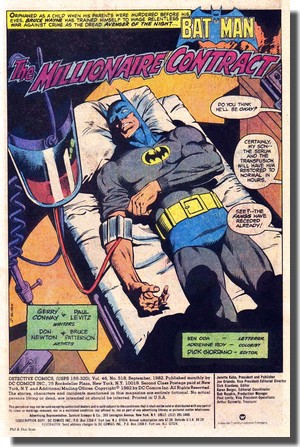 |
|
|
|
| |
| Back in
1939, when the Batman first encounters the Monk and
follows him to his lair in the Carpathian Mountains of
Hungary in Detective Comics #32, the Darknight
Detective actually kills both the Monk and Dala by
shooting them with silver bullets as he finds them
helplessly lying in their coffins. |
| |
| Typical as this was
for Batman's very early days, such an
ending was of course completely
unthinkable in 1982. Instead,
Gerry Conway - in what is in actual
fact an update of the original tale to
establish an "Earth-One counterpart"
of the Monk in the days of the DC Comics Multiverse
- showed the readers
both the Monk and Dala as restrained
captives who were about to be taken away
by Father Green to St Jude's Hospital,
where he planned to "help" them
- something that he has, as he tells
Alfred and Robin, been wanting to do
"for so very long".
|
|
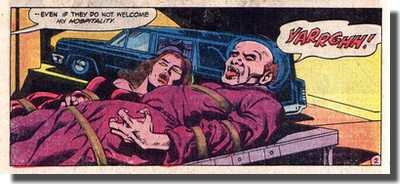 |
|
|
| |
| With these
words, the vampires are loaded into his hearse-like
limousine. The priest bids Robin and Alfred goodbye and
drives off. It is only then that Dick Grayson remarks to
Alfred that there is something very strange about Father
Green and the way he knew all he did about vampires. |
| |
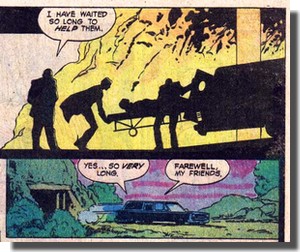 |
|
Rather more
concerned with getting to grips
with the various threats to
blowing his master's secret
crime-fighting identity, Alfred
agrees but quotes the old adage
about not looking a gift horse in
the mouth. Readers who
were by now familiar with Gerry
Conway's plotting probably raised
an eyebrow here and were fully
expecting to see more of Father
Green - and possibly the Monk and
Dala, too. And Conway was just as
obviously enjoying himself as he
was dropping some plot
breadcrumbs - after all, just how
and where indeed did Father Green
get all his knowledge about
vampirism from ? What exactly did
he mean by wanting to
"help" the Monk and
Dala - and just how long a time
was "so very long" ?
Maybe it was all as benevolent as
it seemed ... or maybe not ?
|
|
|
|
| |
| Gerry
Conway (who was just about to turn 30 when he penned the
Batman vampire story) would continue to write both Batman
titles up until the May 1983 cover date issues (Batman
#359 and Detective Comics #526), but neither he
nor anyone else to this day has ever brought back Father
Green - including Matt Wagner who revisited the
characters once again in 2006 in his mini-series Batman
and the Mad Monk - adding amongst other things the
adjective to the villain's originally plain name. |
| Following the three
page Monk story arc epilogue, the
remainder of Detective Comics #518
continues the subplot of counteracting
the potential threat of disclosure of
Batman's secret identity. This
is dispelled for good when
sniper-for-hire Deadshot (who was
introduced in a teaser featured in the
last panels of Batman
#351) attempts to shoot
Bruce Wayne in public (impersonated by
Christopher Chance aka The Human Target)
but is stopped by the Batman crashing in
on him.
|
|
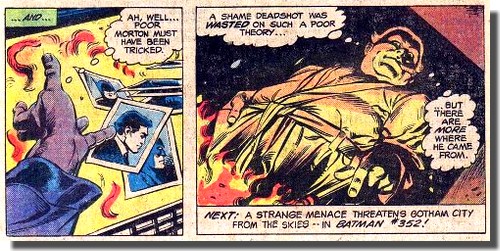 |
|
|
| |
REVIEW &
ANALYSIS
Clearly,
this epilogue functions primarily as a link between the
two Batman titles now running in sync. In essence, it
provides the last few scenes of an adventure which for
the most part took place in Batman (Batman #349, Batman #350 and Batman #351) and was only a full
feature of one single issue of Detective Comics (#517) - and which has
every quality a classic Batman story needs, with Conway
providing some highly intense storytelling. It is all
done with style: an interesting story with sublime
characterization and a love for details - you can almost
feel the rain, smell the city streets, hear the rustling
of the undead, and see the action unfold, not the least
because of the dynamic and atmospheric by Gene Colan, who
provided four issues of pencils in a row within a
publication timeframe of eight weeks.
From a
conventional point of view this epilogue would have been
far better placed, of course, in the next upcoming issue
of Batman - however, the crossover logic between
Batman and Detective Comics was a
decidedly different one - as illustrated by the final
panels of Batman #351, where Deadshot is
introduced merely to point to the continuation of events
in Detective Comics #518 - readers of Batman
would see nothing more of Deadshot after that teaser, as
the entire storyline involving the sniper-for-hire was
told in Detective Comics #518.
This,
quintessentially, was how Dick Giordano as editor and
Gerry Conway as writer were handling the overall
crossover approach: by introducing short incursions of
the storyline from Batman in Detective
Comics (and vice versa), the two titles were tied
together even if the main content remained a separate
Batman adventure. And the best places to place such
incursions were, of course, the first and final pages.
This, together with a few editorial references to
previous overall plot developments, tied up the entire
concept nicely and made sure that Batman and Detective
Comics meshed like a set of toothed wheels - and
served the purpose of getting readers of one title to buy
the other as well.
|
| |
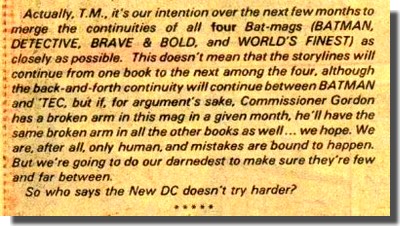
From the
letters page of Detective Comics #523
|
|
By now, the two titles did
start to feel like one single title in simply two
incarnations - and even as far as visuals went
the differences were virtually negligable as the
key-word BATMAN featured in
the logos of both titles and, if anything, was
even more prominent on the covers of Detective
Comics. The cross-over between the
two titles actually worked very well by now and
was on its way to becoming a natural - thanks,
above all, to Gerry Conway and his writing style,
which balanced out top level stories and subplots
so well. And in a reply to a letter refering to
issue #518, editorial sketched out its intention
to take this to an even higher level by including
all four Batman titles.
|
|
| |
COMMENTS FROM THE BATCAVE
(from
the letters page of Detective Comics #523)
|
| |
 |
|
"Your practice of
treating the two Batman solo mags as essentially
two parts of one whole seems to be
well-established now (...) I should compliment
you on achieving perhaps the ultimate in
"merging" the two Bat-Mags. A letter I
had written to BATMAN was published essentially
unchanged in this issue of TEC [#518] - and
didn't look at all out of place." (T. M.
Maple, Toronto, Canada)
|
|
| |
BATMAN and all
related elements are the property of DC
Comics, Inc. TM and © DC Comics, Inc., a
subsidiary of Time Warner Inc.
The illustrations presented here are
copyright material. Their reproduction
for the review and research purposes of
this website is considered fair use as
set out by the Copyright Act of 1976, 17
U.S.C. par. 107.
|
| |
Text is (c) 2014
A. T. Wymann
page
first posted on the web 22 June 2014
|
|
|









